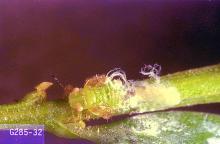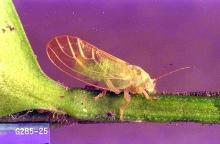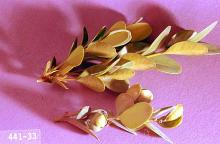Spanioneura buxi
Pest description and damage This distinctive green adult psyllid is about 0.125 inch in length and has an orange abdominal tip. Adult psyllids resemble aphids but can jump and fly. The immature psyllids (nymphs) are covered with a white, waxy secretion that gives them a cottony look. The nymphs feed on the developing buds and new growth. The cupping of leaves at the tips of terminals is a common symptom of psyllid infestation. Buds in cupped leaves often are dead.
Biology and life history The insect overwinters as spindle-shaped orange eggs under bud scales on boxwood. As the buds open in early April, the eggs hatch and the nymphs begin to feed. Adults are found by late May. There is only one generation per year.
Management-biological control
Lady beetles, lacewings, and parasitic wasps are all effective controls for this pest. Avoid the use of broad-spectrum sprays that would disrupt these controls.
Management-cultural control
English boxwood (Buxus sempervirens) is reportedly less susceptible.
Management-chemical control
See Table 1 in:




